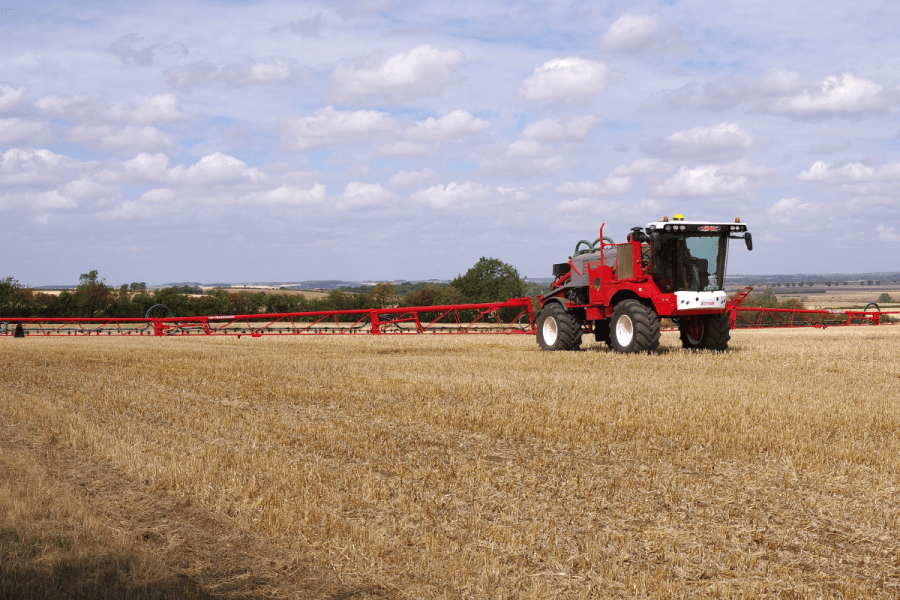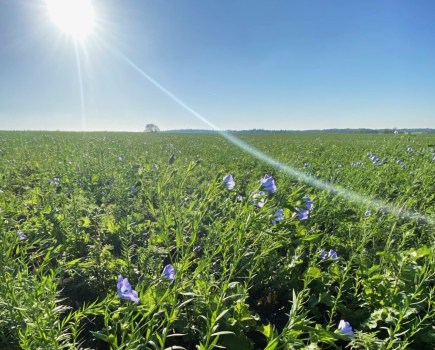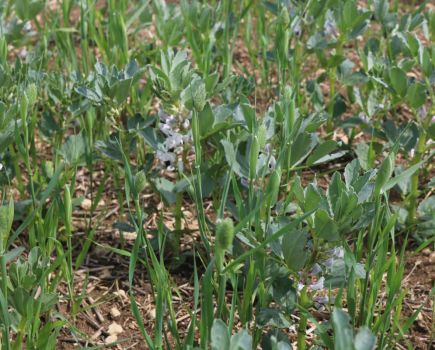Are arable farmers focusing enough on keeping pesticides out of water? CPM reports
“We very much want to encourage productive, vibrant farming practices. But when losses are happening from the land, the water environment sees that very quickly”
By Mike Abram
It could be taken as a positive sign for farming that minimising the risks from pesticides only merits two paragraphs in the Government’s April 2023 ‘Plan for Water: our integrated plan for delivering clean and plentiful water’.
But while fundamentally the water protection measures put in place by the industry have helped, there can be no false sense of security about the need for continued focus and improvement from all sectors.
In a perfect world the water industry would be an unseen entity that nobody heard or saw, requiring no engagement with the agricultural industry, suggests Richard Reynolds, senior agronomy adviser for Anglian Water.
Unfortunately, the reality is that agriculture does impact clean water supplies, he says.
“We very much want to encourage productive, vibrant farming practices,” Richard stresses. “But what we see is when losses are happening from the land, the water environment sees that very quickly.”
Historically, water companies typically reacted by just building bigger and better machines to clean and remove contaminants from water, and because of that insurance, didn’t necessarily need to engage with farmers.
But by working with farmers, there’s effectively an opportunity for a win: win situation, he claims.
“We know farmers are not trying to lose nutrients and pesticides into water – they cost a lot so there is a strong commercial incentive to improve, reduce those losses, and at the same time improve the efficiency of their businesses, helping keep farming productive.
“It’s why we’re spending a lot more time engaging with farmers – we’re seeing these outputs and measurements [of losses] and it’s something that ties into their businesses.
“It’s how can we help farmers so ideally everything that is used on the field, stays in the field. That’s my gold standard, and if you don’t need to use it in the first place, that’s even better.”
Farmers probably don’t value water as a commercial asset, per se, he suspects, certainly compared with producing food. “But water bodies are a really important indicator that provides a good sense check for farms, whether it is through soil erosion, chemicals washing off, or turbidity in streams.”
Understanding why those losses are happening is valuable information for growers, he stresses. “So we need to spend more time talking to farmers, sharing, so they can get a good understanding of where those losses are and why they are occurring.
“In the same way as an agronomist or accountant will be discussing why they’re losing money by doing certain things or practices, it’s another measure on the business.”
But he admits that getting locally relevant water quality information to individual farmers is difficult, even though the water companies collect a lot of data from monitoring. “A number of groups including water companies and the Environment Agency have detailed understanding of contaminants in rivers, but very little gets back to the farmer at the local level fast enough for them to do something about it,” he says.
That’s where collaboration and partnerships are vital. “The water companies might be the source of the information but are not necessarily the first choice of trusted broker, and why we make a point of spending time with the Voluntary Initiative.
“We share information with it every quarter about the levels of pesticides we are detecting, but it is the credibility of the people in the VI team and manufacturers like BASF that take that message back, contextualise it to the needs of the local farmers and agronomists.”
The Voluntary Initiative plays a hugely important role in facilitating collaboration between water companies, regulators, pesticide manufacturers, growers and agronomists, adds Phil Jarvis, VI’s chair as well as chair of farming and environment at Albanwise.
“When a water company highlights concerns, we can help with various solutions, such as digital technology, knowledge trails, annual training events and targeted catchments to solve the issue.”
Phil suggests it is important for those communications to reach agronomist, farm manager and sprayer operator. “They can sometimes be the same person, but often it is three individuals. They all have a part to play in planning and managing applications, through to actually applying and cleaning up after, whether it’s the sprayer or disposing of spray cans.”
A lot of credit for the progress made in protecting water should go to farmers, stresses Jon Williams, public and government affairs manager for BASF. “Farmers are looking at changing farming practices to build resilience into soils, while Sustainable Farming Incentive and Environmental Land Management schemes are also helping and encouraging farmers to protect water.
“Farmers are thinking this way because they know if we’re not careful the pressure will come on current tools, whether from water companies or regulators, and that will have only one outcome – a downward pressure on food production.”
Building resilience into soils is a key aspect of reducing the likelihood of pesticides reaching water, as well as having a huge number of production benefits.
“We’re all duty bound in agriculture to look at how we can build the required resilience in soils,” Jon adds. “At BASF we have Project Fortress at The Grange in Northamptonshire looking at how we can supercharge the soil and slowdown that water transfer.”
Understanding the functionality of soils is definitely helpful, Phil says. “Improving soil health delivers a number of benefits, one of which is managing water, and what comes out of fields.”
It’s also part of how farms will transition from today’s practices to where they need to be in five years’ time, Jon interjects. “Soil health and structure changes are not practices that are taken lightly on farm – it’s fundamental changes, for example, in cropping, cultivations or taking land out of production.
“And it doesn’t just slow down water but builds resilience to climate change.”
Climate change could potentially affect the availability of water in different regions. “That could change farming practices across the country,” he suggests.
Project Fortress trials at The Grange over the past three years, which compare business-as-usual arable cropping with rotations with cover cropping and herbal leys integrating livestock, have demonstrated that if farming practices change, soils can become healthier and retain more water, he says.
The Grange projects are just one part of BASF’s investment in water stewardship and related activities, Jon notes. A second partnership on a farm near Rawcliffe Bridge in Yorkshire has long allowed water stewardship and other sustainability discussions with stakeholders.
“We’re very keen to bring other parties into these conversations,” Jon says. A recent example was a water day held in the summer that brought the Environment Agency, the VI, Anglian Water, distributors, agronomists, farmers and spray operators together to discuss protection of water.
“We all have our challenges , but we want to protect water and the wider environment,” he notes. “But it is only when we actually come together that we can make the biggest impact in addressing those challenges and working collaboratively.”
An example is the feedback BASF has received for a planning and mapping tool developed as part of the ‘Know the Bentazone Risk’ initiative.
The initiative, a collaboration between Better Bentazone Together group members BASF, NuFarm and Sharda International, started in 2021, after Environment Agency data highlighted the pea, bean and potato herbicide, bentazone, was the most frequently detected approved pesticide in groundwater and increasingly being also found in surface waters.
“The Better Bentazone Together group provides good stewardship advice about how to keep bentazone out of water, which is very much related to high-risk areas,” Jon explains.
“The mapping and planning tool provides guidance on where you can and cannot apply bentazone, but we’re reviewing the tool following discussions with stakeholders. The aim is to make it smarter and easier to use for end users.”
It’s not the only digital tool BASF has developed to help farmers and advisers with application timing. The ‘wHen2g0’ was developed in conjunction with Agri-Tech Centre, Agrimetrics, which connects disparate data sources to harness the power of big data and advanced analytics.
The tool evaluates a combination of soil type, drainage, cultivation method and weather to provide an eight-day forecast with a traffic light system to indicate the optimum timing for the least risk to water when applying the oilseed rape herbicides metazachlor and quinmerac.
“Again, it’s making sure the products are actually maintained within the field and not running into water,” Jon says. “The collaborative bit is making sure a wide audience is aware of the tool and why they should use it. It’s about education and knowledge transfer to ultimately protect of water.”
Reaching a wide audience isn’t always straightforward, Phil notes, although he is encouraged by the response from industry meetings earlier this summer. “We’ve had about 15 follow ups from organisations wanting to take what they heard further. That includes farmers, water companies and manufacturers, so from any embryonic 60 attendees that’s snowballed into something much bigger.”
Wider stakeholder engagement is crucial as it provides larger outreach to different end users, Jon adds. “We can then have that collaborative approach where the challenges can be shared and we can try to address them in unique ways, whether it is directly on farm with advice, or through improving agronomists education level to understand how certain compounds act and can explain that process.”
Ultimately the key is to reach sprayer operators who actually put this into practice, Phil adds. The VI oversees the running of the National Register of Sprayer Operators (NRoSO), with scheme administrator BASiS. It is an important route to influence and encourage best practice.
“But we have to find other ways to engage them. As very practical people, you have to choose carefully when you will get their attention. It’s not likely to be in the middle of lambing, silage making or harvest.
“But if you can combine it with something else, for example the BASF days, that can be more successful. Winter is another key period, when farmers do attend more knowledge transfer events.”
The VI is putting a particular focus on water stewardship this autumn and winter, he adds. “There will be knowledge trails at events, while the NRoSO annual training event will include lots of water protection training. All sides want to see progress, and it is one of the strategic aims of the Voluntary Initiative.”
In the longer term, the increased focus on integrated pest management should also help boost water protection on farm, adds Dr Neal Evans, director of operations for the Voluntary Initiative.
“We were buoyed by the inclusion of the IPM 1 standard in SFI,” he says. “It encourages farmers to discuss with their agronomist their IPM strategy and plan for the next 5-10 years, reviewing that on an annual basis.”
IPM offers the potential to mitigate or reduce the use of pesticides, making sure they are only used when needed.
Two tools have been developed with VI involvement to help with IPM planning and implementation. The VI IPM plan developed with the NFU which offers a broad whole farm approach to IPM, while an IPM Planning tool developed by ADAS and SRUC allows a more in-depth analysis of specific weed, pest and disease threats on a field-by-field and crop specific basis.
This article was taken from the latest issue of CPM. Read the article in full here.
For more articles like this, subscribe here.
Sign up for Crop Production Magazine’s FREE e-newsletter here.




